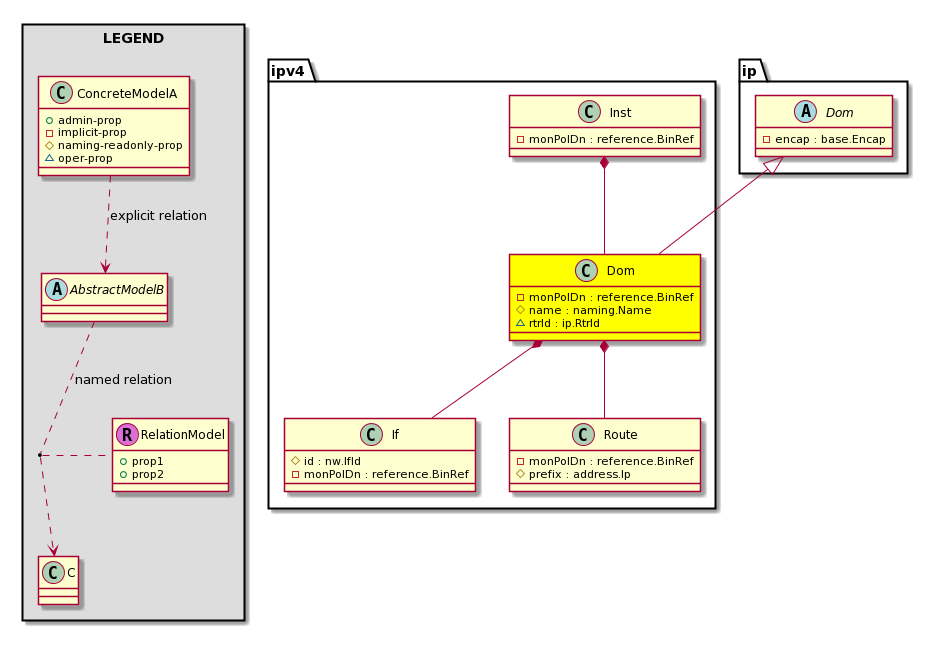![[V]](styles/eye.gif) |
ipv4:Dom The domain (VRF) information. |
├
|
![[V]](styles/eye.gif) |
fault:Counts An immutable object that provides the number of critical, major, minor, and warning faults raised on its parent object and its subtree. |
├
|
![[V]](styles/eye.gif) |
health:Inst A base class for a health score instance.(Switch only) |
├
|
![[V]](styles/eye.gif) |
ipv4:If A container for IPV4 information that is operated at an interface level. |
|
├
|
![[V]](styles/eye.gif) |
fault:Counts An immutable object that provides the number of critical, major, minor, and warning faults raised on its parent object and its subtree. |
|
├
|
![[V]](styles/eye.gif) |
health:Inst A base class for a health score instance.(Switch only) |
|
|
├
|
![[V]](styles/eye.gif) |
fault:Counts An immutable object that provides the number of critical, major, minor, and warning faults raised on its parent object and its subtree. |
|
|
├
|
![[V]](styles/eye.gif) |
fault:Inst Contains detailed information of a fault. This object is attached as a child of the object on which the fault condition occurred. One instance object is created for each fault
condition of the parent object. A fault instance object is identified by a fault code. |
|
|
├
|
![[V]](styles/eye.gif) |
health:Inst A base class for a health score instance.(Switch only) |
|
|
├
|
![[V]](styles/eye.gif) |
ip:RsIpAddr A source relation to the connectivity parameters for an interface. |
|
├
|
![[V]](styles/eye.gif) |
fault:Counts An immutable object that provides the number of critical, major, minor, and warning faults raised on its parent object and its subtree. |
|
├
|
![[V]](styles/eye.gif) |
fault:Delegate Exposes internal faults to the user. A fault delegate object can be defined on IFC (for example, for an endpoint group) and when the fault is raised
(for example, under an endpoint policy on a switch), a fault delegate object is created on IFC under the specified object. A fault delegate object follows the lifecycle of the original fault instance object, being created, modified, or deleted based on the changes of the original fault. |
|
├
|
![[V]](styles/eye.gif) |
health:Inst A base class for a health score instance.(Switch only) |
|
|
├
|
![[V]](styles/eye.gif) |
ip:Cons Used for maintaining consumers of a static route from an IPRoueDef. |
|
|
├
|
![[V]](styles/eye.gif) |
ip:Cons Used for maintaining consumers of a static route from an IPRoueDef. |
|
|
├
|
![[V]](styles/eye.gif) |
fault:Counts An immutable object that provides the number of critical, major, minor, and warning faults raised on its parent object and its subtree. |
|
|
├
|
![[V]](styles/eye.gif) |
fault:Delegate Exposes internal faults to the user. A fault delegate object can be defined on IFC (for example, for an endpoint group) and when the fault is raised
(for example, under an endpoint policy on a switch), a fault delegate object is created on IFC under the specified object. A fault delegate object follows the lifecycle of the original fault instance object, being created, modified, or deleted based on the changes of the original fault. |
|
|
├
|
![[V]](styles/eye.gif) |
fault:Inst Contains detailed information of a fault. This object is attached as a child of the object on which the fault condition occurred. One instance object is created for each fault
condition of the parent object. A fault instance object is identified by a fault code. |
|
|
├
|
![[V]](styles/eye.gif) |
health:Inst A base class for a health score instance.(Switch only) |
|
|
├
|
![[V]](styles/eye.gif) |
fault:Delegate Exposes internal faults to the user. A fault delegate object can be defined on IFC (for example, for an endpoint group) and when the fault is raised
(for example, under an endpoint policy on a switch), a fault delegate object is created on IFC under the specified object. A fault delegate object follows the lifecycle of the original fault instance object, being created, modified, or deleted based on the changes of the original fault. |
|
|
├
|
![[V]](styles/eye.gif) |
fault:Delegate Exposes internal faults to the user. A fault delegate object can be defined on IFC (for example, for an endpoint group) and when the fault is raised
(for example, under an endpoint policy on a switch), a fault delegate object is created on IFC under the specified object. A fault delegate object follows the lifecycle of the original fault instance object, being created, modified, or deleted based on the changes of the original fault. |
|

